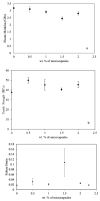Effect of Self-Healing by Dicyclopentadiene Microcapsules on Tensile and Fatigue Properties of Epoxy Composites
- PMID: 37512465
- PMCID: PMC10384437
- DOI: 10.3390/ma16145191
Effect of Self-Healing by Dicyclopentadiene Microcapsules on Tensile and Fatigue Properties of Epoxy Composites
Abstract
Microcapsules of urea-formaldehyde (UF) containing dicyclopentadiene (DCPD) were synthesized by the in situ polymerization technique for self-healing of epoxy. The dispersion of microcapsules in the epoxy matrix was achieved using ultrasonication. Composites of epoxy, having 0.5, 1.0, 1.5, and 2.0 wt.% of microcapsules capable of self-healing, were prepared. The shape and size of the microcapsules were determined by field emission electron microscopy. Spherical capsules of DCPD, with an average diameter of 172 nm, were obtained. Investigation of tensile properties indicated a decrease in the tensile modulus with an increase in wt.% of microcapsules. There was a reduction of 22%, 27%, 39%, and 30% in the elastic modulus of composites for 0.5, 1.0, 1.5, and 2.0 wt.% of microcapsules, respectively. Tensile strength was found to increase with an increase in wt.% of microcapsules. The tensile strength of the composites increased by 33%, 20%, 8%, and 21% for 0.5, 1.0, 1.5, and 2.0 wt.% of microcapsules, respectively, in comparison with that of neat epoxy. The fatigue life of composites was investigated by conducting uniaxial tension-tension fatigue tests at constant stress amplitudes of 20, 25, 30, and 35 MPa, at a constant stress ratio (R = 0.1) and a frequency of 3 Hz. The fatigue life of composites increased with an increase in wt.% of microcapsules in comparison with that of neat epoxy. It was found that the fatigue life of the composites decreased with 1.5 and 2.0 wt.% of microcapsules in comparison with composites with 0.5 and 1.0 wt.% of microcapsules. The fracture surfaces of the tested samples were examined with the help of scanning electron microscopy (SEM) to understand the various mechanisms responsible for the change in modulus, strength, failure strain, and fatigue life of composites.
Keywords: fatigue life; mechanical characterization; polymer composites; self-healing composites; tensile properties.
Conflict of interest statement
The authors declare no conflict of interest.
Figures
















References
-
- Reifsnider K.L., Schulte K., Duke J.C. Long-Term Fatigue Behaviour of Composite Materials. In: O’Brien T.K., editor. Long-Term Behaviour of Composites. ASTM; West Conshohocken, PA, USA: 1983. pp. 136–159.
-
- Brown E.N., Kessler M.R., Sottos N.R., White S.R. In situ poly (urea-formaldehyde) microencapsulation of dicyclopentadiene. J. Microencapsul. 2003;20:719–730. - PubMed
-
- Yin T., Rong M.Z., Zhang M.Q., Yang G.C. Self-healing epoxy composites–preparation and effect of the healant consisting of microencapsulated epoxy and latent curing agent. Compos. Sci. Technol. 2007;67:201–212. doi: 10.1016/j.compscitech.2006.07.028. - DOI
-
- Rule J.D., Sottos N.R., White S.R. Effect of microcapsule size on the performance of self-healing polymers. Polymer. 2007;48:3520–3529. doi: 10.1016/j.polymer.2007.04.008. - DOI
LinkOut - more resources
Full Text Sources

